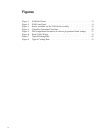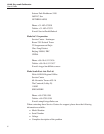
ELECTRICAL SHOCK
•
These guidelines must be followed to ensure that the safety mechanisms
in this instrument will operate properly. This instrument must be plugged
into a 115 VAC, 60Hz (230 VAC, 50Hz optional), AC only electric outlet.
The power cord of the instrument is equipped with a three-pronged
grounding plug for your protection against electrical shock hazards. It
must be plugged directly into a properly grounded three-prong receptacle.
The receptacle must be installed in accordance with local codes and ordi
-
nances. Consult a qualified electrician. DO NOT use an extension cord or
adapter plug.
•
If supplied with user accessible fuses, always replace the fuse with one of
the same rating, voltage, and type.
•
Always replace the power cord with an approved cord of the correct rat
-
ing and type.
•
HIGH VOLTAGE is used in the operation of this equipment. SEVERE
INJURY or DEATH may result if personnel fail to observe safety precau
-
tions. Before working inside the equipment, turn power off and discon-
nect power cord.
1.2.2
CAUTIONS
• Always operate this instrument at room temperature between 41°F and
122°F (5°C to 50°C). Allow sufficient air circulation by leaving at least 6
inches (15 cm) of clearance around the instrument. Overhead clearance is
required. DO NOT place unit under any structure.
• Component lifetime can be shortened by continuous high temperature op-
eration.
•
DO NOT leave the sleeve(s) in the instrument for prolonged periods. Due
to the high operating temperatures of the instrument, the sleeves should be
removed after each use and buffed with a Scotch-Brite® pad or emery
cloth. (See Maintenance, Section .)
•
DO NOT apply any type of voltage to the display hold terminals. Apply
-
ing a voltage to the terminals may cause damage to the controller.
•
DO NOT use fluids to clean out the well. Fluids could leak into electron
-
ics and damage the instrument.
•
Never introduce any foreign material into the probe hole of the insert.
Fluids, etc. can leak into the instrument causing damage.
•
DO NOT change the values of the calibration constants from the factory
set values. The correct setting of these parameters is important to the
safety and proper operation of the calibrator.
•
DO NOT slam the probe sheath in to the well. This type of action can
cause a shock to the sensor and affect the calibration.
9140 Dry-well Calibrator
User’s Guide
4


















